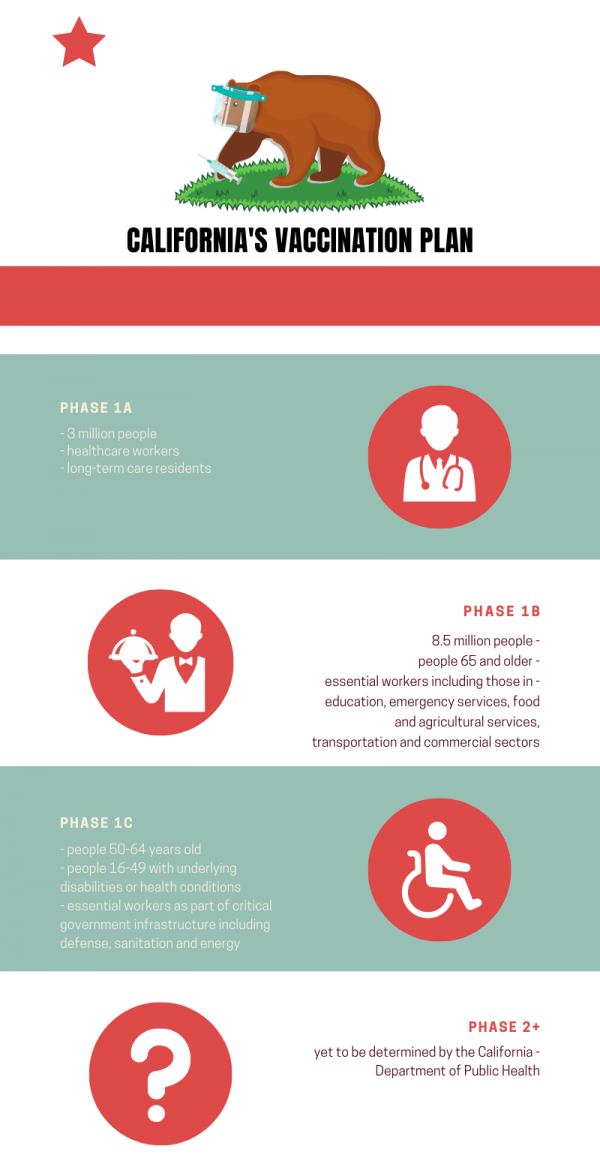A Guide to the COVID-19 Vaccine
The recent distribution of the COVID-19 vaccine has reached the arms of most frontline health care workers, while students, teachers, and the general public wait for their chance to receive the vaccine as the world slowly returns to normality.
The Centers for Disease Control and Prevention (CDC) created three phases of vaccine distribution.
Phase 1 consists of health workers and significantly high-risk adults.
Phase 2 contains all the K-12 teachers and staff as well as older adults not vaccinated in Phase 1.
Phase 3 includes all young-adults and children as well as the rest of the adults not vaccinated.
The three phases were constructed to “balance the prevention of mortality and the preservation of societal functioning” according to the CDC.
Both the Pfizer/BioNTech and the Moderna vaccine have been developed, approved and distributed, but have small differences.
Pfizer shows 95% efficacy at preventing COVID-19 symptoms, has an interval of 21 days between doses of vaccine but requires special ultra-cold freezers for storage.
The Moderna vaccine shows 94.1% efficacy and has an interval of 28 days between doses, but only needs the temperature of a regular freezer as storage.
Although both vaccines have shown a very high percentage of effectiveness against COVID-19 symptoms, there is no evidence as to whether or not the vaccine can actually prevent the spread of the virus.

For maximum effectiveness, there are two doses of the vaccine administered usually three to four weeks apart. The first dose helps the immune system create a response against the virus, while the second dose ensures long-term protection.
Getting vaccinated also comes with the cost of minor symptoms The Palliative Care Medical Director for Torrance Memorial Health System, Ujjwala Dheeriya, received both doses of the Pfizer vaccine.
Some symptoms include “aching joints and a slight dizziness,” Dheeriya said. “[Feeling symptoms] is proof that your immune system is responding to the vaccine.”
The COVID-19 vaccine distribution has advanced past only medical workers and is being administered to Los Angeles County residents that are 65 years and older.
According to the LA County Department of Public Health, it is likely to be available to the general public in the spring of 2021. Among the general public, teachers are hopeful to receive the vaccine by early February as the first tier of Phase 1B in California’s vaccine plan.
Some teachers believe that returning to campus would not be safe with vaccination so close.
“Ethically it is inexcusable to put teachers, staff and their families in danger when effective vaccines are available. We can wait. Education can be replaced. Lives are not replaceable,” said history teacher Louis Harley.
Although the PVPUSD district hasn’t released a direct statement yet regarding the requirements of students to return to an in-person learning environment, the Los Angeles Unified School District Superintendent Austin Beutner will require all students to be vaccinated before returning to school.
“Our students getting vaccinated would be a very necessary precaution for me to personally feel safe returning to an in-person learning environment,” junior Jonathan Ross said.
Students and young adults are considered to be low risk, which means they are last in line to receive the vaccine.
Returning to an in-person learning environment is “unlikely,” Dheeriya said. “The percentages [of cases] need to drop many tiers. The vaccine likely won’t have a large effect on returning to school [before the end of the school year] because of the long amount of time the vaccine takes to become fully effective.”
With over one million cases and around 15 thousand deaths in L.A. County alone, the COVID-19 vaccine is a small light at the end of a long tunnel. With students being among the last to receive the vaccine and the continuing disregard of social distancing and mask-wearing, a return to normal life with sports and school still will require time.
“It’s like turning a ship, Dheeriya said, “and it’s a very large ship that needs to be turned.”